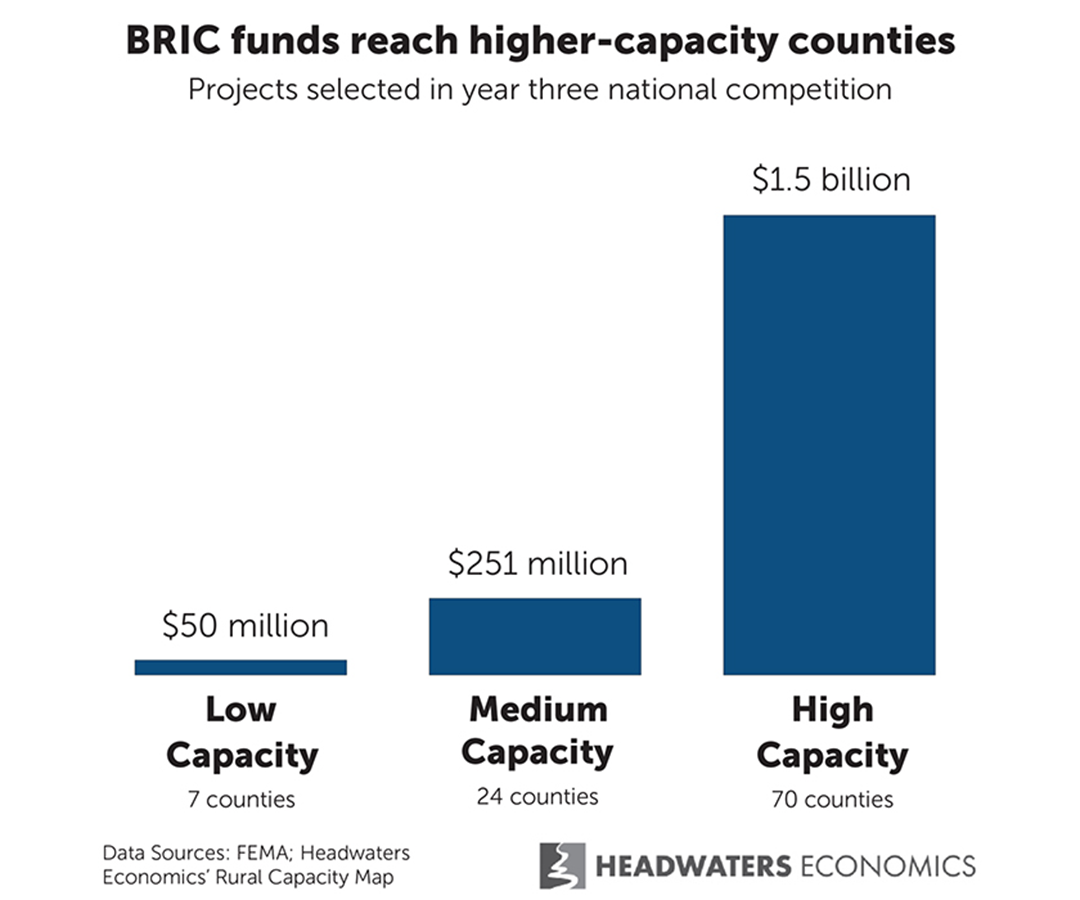
Rural communities still at a disadvantage when competing for government grants
Rural communities still at a disadvantage when competing for government grants
Rural communities continue to be left out of federal funding opportunities despite efforts from the Biden administration to invest in rural America, according to a new analysis.
Most of the funding in a recent round of climate-change grantmaking went to high-capacity communities located in coastal states, according to a report by the nonprofit Headwaters Economics. Less than a fifth of the grants went to "low-capacity" communities, which tend to be rural, according to Kristin Smith, author of the study.
Smith analyzed the most recent round of grants made through FEMA's Building Resilient Infrastructure and Communities (BRIC) program, which were released in August 2023. She said low-capacity communities that did not fare well in the competition lack the staff and expertise necessary to create competitive proposals for federal grant programs.
"Many of the [rural] communities that I've worked with and know very well, their staff members are struggling just to stay on top of day-to-day operations," Smith said in a Daily Yonder interview. "And so when you ask them to… identify and think through a project that could actually decrease their natural disaster risk, they often just don't have the time to do it, let alone the resources or maybe even the knowledge for where to start."
Match requirements, which is money awardees must contribute themselves to a grant-funded project, can also be a barrier for rural communities with small budgets or less access to philanthropic funding, according to Smith.
The Biden administration has made efforts to bring opportunities to rural America, most notably with the Rural Partners Network, which connects rural communities directly to federal officials for help with funding applications. Additionally, an updated technical assistance guide was released by the White House in September to increase rural communities' access to funding from the Bipartisan Infrastructure Law and the Inflation Reduction Act.
But a rural-urban disparity played out in this year's BRIC funding, which is paid through an apportionment of the Federal Emergency Management Agency's (FEMA) disaster relief fund: Only 3% of the counties that received grants are low-capacity, as defined by Headwaters Economics' Rural Capacity Index.

Disparity among counties is stark relative to their capacity
High-capacity counties – which have the staff, resources, and expertise to apply for and win federal grants – were chosen 83% of the time.
FEMA is aware of these findings. In an email to the Daily Yonder, a FEMA spokesperson said that FEMA is "currently in the process of reviewing the findings in the Headwaters Economics article and are open to engaging."
The spokesperson also emphasized that approximately $1.3 billion of the $2.2 billion in the most recent BRIC grants went to disadvantaged communities. FEMA is following the Biden administration's Justice40 initiative, which aims to allocate 40% of federal investments to disadvantaged communities that are "marginalized, underserved, and overburdened by pollution."
Disadvantaged communities, which are defined by indicators such as poverty, unemployment, and racial segregation, are not synonymous with Headwaters' definition of low capacity.
Many of the chosen disadvantaged communities for the 2023 funding cycle are on the coast: This year, 78% of BRIC funding went to more populated East and West Coast states and 22% went to interior and Gulf Coast states, according to the Headwaters Economics analysis. New York City and San Francisco metropolitan areas have been most successful at obtaining BRIC funding not just this year but every year of the program so far.
"So much of that money is going to disadvantaged neighborhoods for very good, important projects," Smith said. "I think it's really important not to pit places against each other.
"To me, it's like, OK, BRIC is working pretty well for [high-capacity communities.] But there's a whole other geography that has really high disaster risk where people's lives are at stake and they're just not able to access the federal funding that we have for [climate] solutions."
Smith's organization has firsthand experience with this challenge: In 2020 – the first year of the BRIC program – Headwaters Economics assisted the small town of Three Forks, Montana, with a grant application for a flooding mitigation project. Even with help from Headwaters Economics and the local engineering firm Great West Engineering, the Three Forks application was rejected by FEMA.
After learning the news, Smith dived into the data of who was awarded grants. "When we did that first round of analysis, we saw that the vast majority of the funding for BRIC was going to the East and West Coasts," Smith said. "And even though we have a ton of disaster risk and resilience needs in the interior U.S., those communities really weren't getting that money."
After Headwaters Economics published its first analysis on the BRIC program awardees in 2020, FEMA connected Three Forks community leaders with the FEMA Region 8 office that serves Montana. The office provided Three Forks with technical assistance for their application, which they resubmitted in 2021, and encouraged them to also apply to the Flood Mitigation Assistance program, a sister program to BRIC.
This time, the community was successful: Three Forks received a nearly $5 million grant from the Flood Mitigation Assistance program. The project is currently in the permitting process.
The award was a rural success story, but could be a rare happy ending for rural communities without access to the resources and expertise to produce competitive grant proposals for funding that is already in high demand. Of the more than $4.6 billion in funding requests submitted to the BRIC program in year three, only $2.3 billion was awarded.
And those numbers only reflect the communities who were able to apply to the program. There's likely many more communities who just didn't have the time and resources to write a grant application, according to Smith.
Unlike many other federal programs, there is no expiration date for the BRIC program. It's funded through an earmarked 6% of estimated disaster expenses every year through FEMA's Disaster Relief Fund, so even for the communities' rejected funds, there is time to reapply.
Whether rural communities are prioritized in future funding awards remains to be seen.
"I do think FEMA is taking the issue seriously, and I also think there's a lot of work to do," Smith said.
This story was produced by Daily Yonder and reviewed and distributed by Stacker Media.



